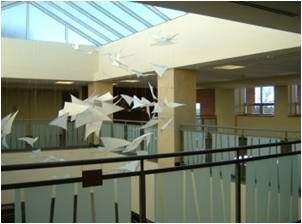Sustainability Program Development
Sustainability Programs incorporate all building stakeholders into the design process, promoting awareness, goal development, implementation, acceptance, and effectiveness of facility sustainability efforts.
Implementation of sustainability programs can be challenging, especially when starting from scratch. Institutional change![]() may be necessary to begin a program, or to help define an existing program’s scope and effectiveness. The U.S. Department of Energy details the change process here
may be necessary to begin a program, or to help define an existing program’s scope and effectiveness. The U.S. Department of Energy details the change process here![]() . Steps include goal determination, tools to achieve the goals, action plan development, plan implementation, and evaluation of results. Several case studies
. Steps include goal determination, tools to achieve the goals, action plan development, plan implementation, and evaluation of results. Several case studies![]() shed light on action plans and energy savings that can be accomplished through energy management systems. See the Green Teams page to learn how to establish a team.
shed light on action plans and energy savings that can be accomplished through energy management systems. See the Green Teams page to learn how to establish a team.
Any sustainability program should begin with consideration of its most critical component: the people in the building. From there, building operators, contractors, and other staff can be involved to introduce best-management practices consistent with industry standards. Take a look at the integrative design process for guidance on developing sustainability-related programs. Development of sustainability programs in a facility is crucial to acceptance of energy management techniques![]() implemented through an Energy Management System. For example, programs could include the following:
implemented through an Energy Management System. For example, programs could include the following:
- Using a green purchasing program to buy Federally approved energy efficient products, and collecting tenant feedback on new technology purchases
- Getting occupants involved in recycling programs
- Waste, water
 , and energy audits
, and energy audits
- HAZMAT reduction program in laboratories
- Programs based on Flexible Workplace Design
 strategies, such as a telework
strategies, such as a telework program
program
These programs benefit all parties involved, from reduced operating costs to improved tenant satisfaction, while furthering environmental sustainability.
Related Topics
Building Performance
Building performance can be measured against various environmental and economic attributes. A key to evaluating building performance is establishing a common set of measurements to be used. Sustainable building standards often consider environmental performance in categories including, energy, water, indoor environmental quality, materials use, waste management, as well as economic performance, such as life-cycle costs.
Guiding Principles for Sustainable Federal Buildings![]()
TechStreet.com | ASHRAE’s Performance Measurement Protocols![]()
Energy Management Systems (EnMS)
Energy Management Systems are a set of business processes that enable facility managers to act on energy usage data and optimize efficiency while identifying areas for improvement. No matter how large or small your organization, implementing a structured energy management system can be a key step to:
- Cutting operational costs
- Achieving continual operational improvement
- Improving risk management
- Staying competitive in the marketplace
For more, see Energy Management Systems and DOE's 50001 Ready Program![]() .
.
Energy Performance
Assessing a building’s energy performance involves comparing its energy use to that of peers or a standard. The ENERGY STAR program provides recognized benchmarks for assessing a building’s energy performance.
Sustainability
Sustainability and sustainable mean to create and maintain conditions, under which humans and nature can exist inproductive harmony, that permit fulfilling the social, economic,and other requirements of present and future generations.
Sustainability Program Development
Sustainability Programs incorporate all building stakeholders into the green design process, promoting awareness, goal development, implementation, acceptance, and effectiveness of facility sustainability efforts.

